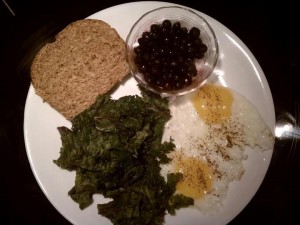I saw this statement again recently, and, while I have touched on it before in other posts, I thought I should finally write a full article about it, because this is a very important principle to understand.
YOU CANNOT OUT-EXERCISE A BAD DIET!
It’s just that simple.
While 20% to 25% of your body composition is controlled by your exercise regimen, 75% to 80% of your body composition is determined by what you eat.
So, then, why do some of the most health-conscious people I know think they can eat just about whatever they want, whenever they want, and then hit the gym to work it off?
A Big Mac Meal, with a medium fries and a 21-ounce Coke, comes in at 1130 calories. Oh, but you drink Diet Coke? 920 calories. That does not include ketchup, which will add a few more carbs (and calories). But let’s not quibble.
A Big Mac Meal is not an absurdly sized meal. It’s easily edible by people for lunch or supper. Many people enjoy the flavors of the Big Mac Meal. If you are one of those people, cool. No judgment here. I’ve had my share of Big Mac Meals.
Don’t like Big Macs? Here are some other typical meals. The calorie totals include a zero-calorie beverage (like diet soda or water).
- Arby’s – Medium roast beef sandwich with medium curly fries – 990 calories
- Taco Bell – 2 Beef Burrito Supremes – 840 calories
- McDonald’s Breakfast – 2 Sausage McMuffins with egg and 1 hash brown – 1050 calories
- KFC – Spicy Crisp chicken breast with cole slaw and beans – 810 calories
- 2 home-made cupcakes with frosting – 1000 calories
Okay, so each of those has 800+ calories. Let’s see what the Mayo Clinic says about calories burned by exercise.
The bigger you are, the more calories you burn, so we include a range of weights. You can adjust the numbers to approximate your calorie burn, based on your weight.
| Activity (1-hour) | Weight of person and calories burned | ||
|---|---|---|---|
| 160 pounds | 200 pounds | 240 pounds | |
| Aerobics, high impact | 533 | 664 | 796 |
| Aerobics, low impact | 365 | 455 | 545 |
| Basketball game | 584 | 728 | 872 |
| Bicycling, < 10 mph, leisure | 292 | 364 | 436 |
| Resistance (weight) training | 365 | 455 | 545 |
| Running, 5 mph | 606 | 755 | 905 |
| Running, 8 mph | 861 | 1,074 | 1,286 |
| Skiing, cross-country | 496 | 619 | 741 |
| Skiing, downhill | 314 | 391 | 469 |
| Stair treadmill | 657 | 819 | 981 |
| Swimming, laps | 423 | 528 | 632 |
| Tai chi | 219 | 273 | 327 |
| Walking, 2 mph | 204 | 255 | 305 |
| Walking, 3.5 mph | 314 | 391 | 469 |
I weigh around 160, so that means to burn off that single Big Mac Meal, I’d need to
- Walk rather quickly for 3 hours
- Run pretty fast for a little more than an hour
- Play basketball or hit the stair stepper — without dogging it or taking any breaks — for about 90 minutes
- Do about 2.5 hours of weight training
Again, that is just to work off one meal.
“Well,” you might reason, “that’s not impossible.”
I will grant you that. Difficult, but not impossible to work off that one meal, but if I am making poor dining decisions all the time, forget about it.
If eating that stuff is worth the extra workout time to you, that’s your decision to make, but it’s not worth it to me. I’d rather have my body spending time building itself than expending energy battling the things I ingest.
I have had this conversation with numerous people over the years. There are two rationalizations I generally hear:
- Everything in moderation.
- Life’s too short to restrict myself.
“Everything in moderation” – You know what? If you are otherwise engaging in health-conscious dining, and can eat from the above-listed or equivalent meals only once per week, I’m with you. Go for it. I doubt many people can do that, though, because once you are eating mostly clean, you simply won’t want the Arby’s sandwich and fries, or the Big Mac, or the cupcakes. That’s what happened to me. But if you can do it, and you really enjoy a weekly pair of Burrito Supremes, then go for it.
“Life’s too short to restrict myself” – I have an easy answer to that, because as far as I’m concerned, life is too short, and I don’t want to make it even shorter by eating what I consider to be junk food that can cause health problems. I don’t measure my life’s success by what I eat, I measure it by what I do, and the longer I live, the more I can do. ‘Nuff said.
Life is a continuous series of choices, so staying informed and making the best choices based on the best information available is important. Once you have all the facts you can gather, then you can decide whether you can out-exercise your diet or not. I choose not to let my diet stand in the way of my fitness goals. How about you?
If you’d like some no-obligation help with your diet or exercise goals, please feel free to contact me. I’m here to help.

